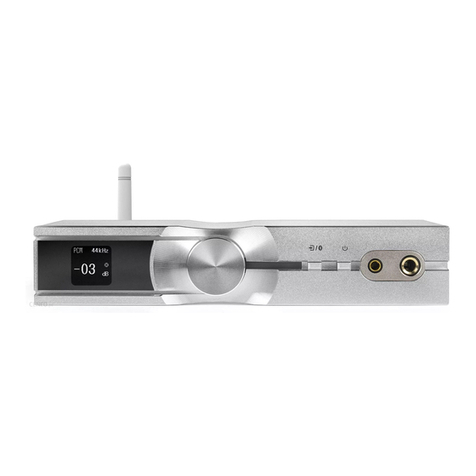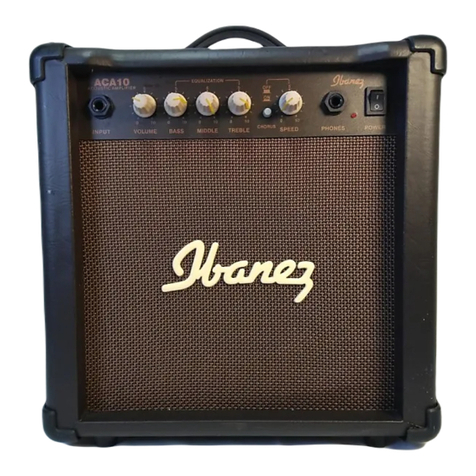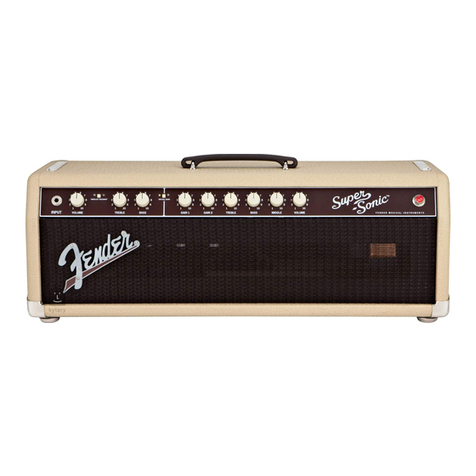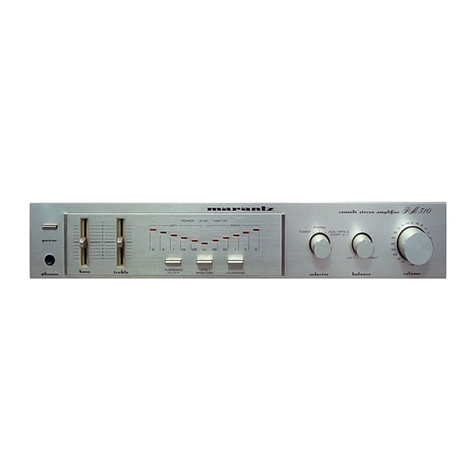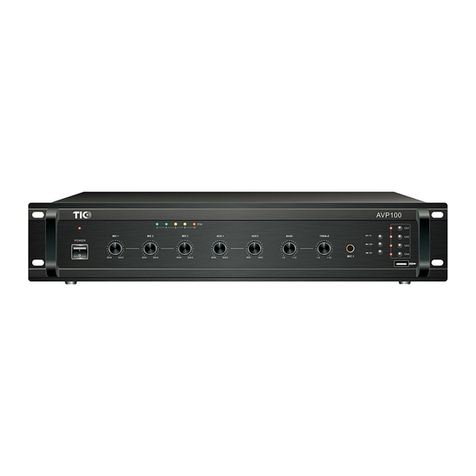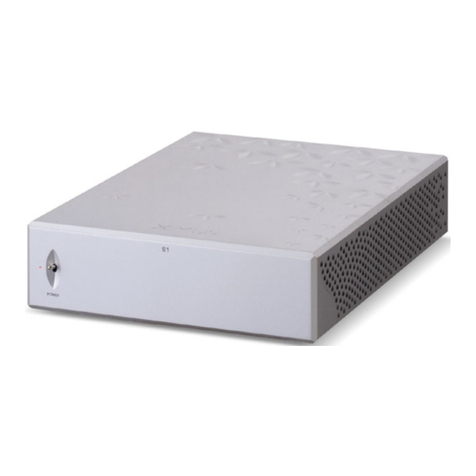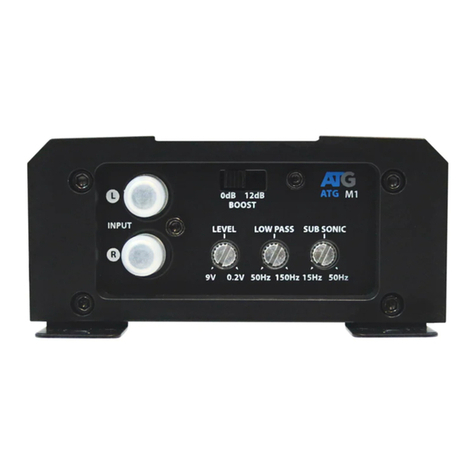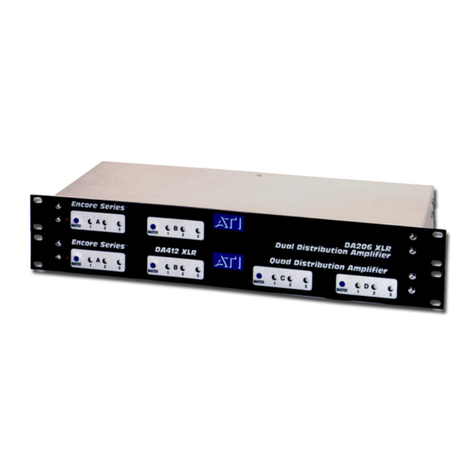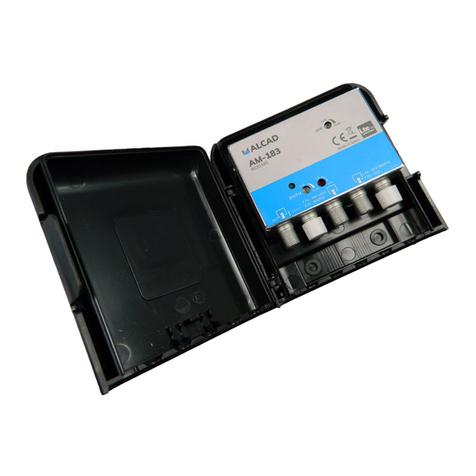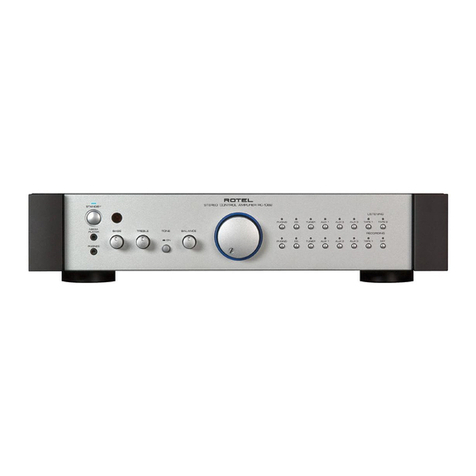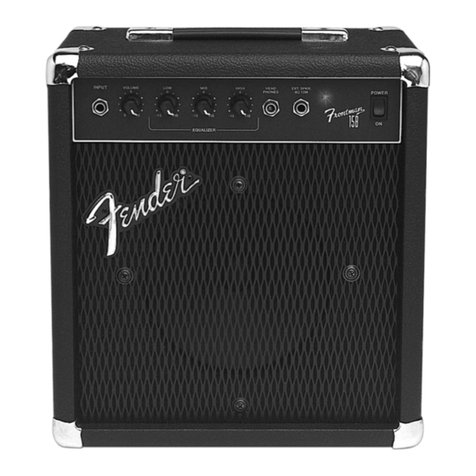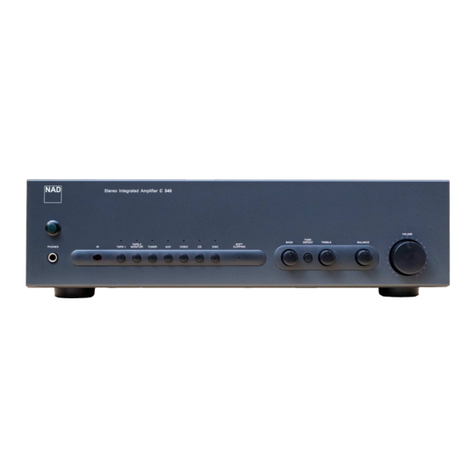Sound Devices MM-1 User manual

SOUND
DEVICES
Sound Devices, LLC
300 Wengel Drive
Reedsburg, WI 53959 USA
Voice (608) 524-0625
Fax (608) 524-0655
www.sounddevices.com
MM-1
Microphone Preamplifier with
Headphone Monitor
User Guide and Technical Information
©2001-2002 Sound Devices, LLC
®
interstage
Phistersvej 31, 2900 Hellerup, Danmark
Telefon 3946 0000, fax 3946 0040
www.interstage.dk
-pro audio with a smile

MM-1 Mic Preamp with Headphone Monitor
User Guide and Technical Documentation
page 2
General Description
Sound Devices MM-1 combines a high-performance microphone
preamplifier with a flexible headphone monitor.
The full-featured, transformer-balanced microphone preamp
produces low-noise, low-distortion gain at all switch positions.
Its dual-stage limiter and high-pass filter prevent occasional sig-
nal extremes from overloading down-stream equipment.
The MM-1 is at home in a range of applications – film sound
(boom operators), high-definition television production, corpo-
rate/industrial environments, radio/television announce booths,
and music production. With its headphone monitoring function
the MM-1 is a benefit in applications where communications
channels and mix-minus feeds need to be monitored in head-
phones. The user can monitor both microphone audio and
external audio sources in headphones with level control.
The MM-1 is designed for durabily. Its extruded aluminum chas-
sis, rugged end panels, machined knobs, and panel mounted
connectors assure reliable mechanical operation.

www.sounddevices.com
page 3
Features
High Performance Microphone Preamplifier
Maximum of 66 dB of gain, in eleven discrete steps for accurate,
repeatable gain settings.
Dynamic range exceeding 120 dB
10 Hz to 50 kHz audio bandwidth.
High immunity to RF interference due to transformers, RF filtering,
and all-metal construction
High current line output driver capable of driving very long cable
runs.
Premium Lundahl input transformer with superior sonic quality
and freedom from interference problems.
Extended range peak limiter via dual opto-isolators makes pream-
plifier virtually "unclippable".
Selectable 48-volt / 12-volt phantom power or 12-volt T-power for
condenser microphones.
High-pass filter with two selectable corner frequencies, 80 and
160 Hz, 6 dB per octave.
Headphone Monitoring
Headphone monitoring of microphone audio, external monitor
audio, or a mix of both.
Monitor input accepts balanced or unbalanced mono line-level
inputs on 1/4-inch tip-ring-sleeve connector.
Separate level control of Monitor gain and overall headphone gain.
Split ear function via DIP switches.
Portable
Internal battery power (two-AA) for convenient, low cost power.
Excellent battery life with alkaline or lithium primary cells.
External 5-17 VDC powering (plug included).
Durable Mechanical Construction
High strength aluminum chassis withstands punishing field condi-
tions.
Panel-mounted connectors for strength and reliability.
Easy access battery compartment for quick battery changes.
Durable belt clip and end panels.

MM-1 Mic Preamp with Headphone Monitor
User Guide and Technical Documentation
page 4
MM-1 Frequency
Response
-- w/80 Hz HP
·· w/160 Hz HP
-6
+1
-5
-4
-3
-2
-1
+0
d
B
u
10 100k20 50 100 200 500 1k 2k 5k 10k 20k 50k
Hz
Block Diagram
Specifications
Gain:
(Mic - Line) 0 dB to 66 dB input to output, switch selectable
Gain Accuracy
(Mic - Line)
+0.6, -0.1 dB with reference to front panel gain markings
(150 ohm source, 100 k load impedances)
Frequency Response
(Mic - Line)
20 Hz –20 kHz, +0.1, -0.5 dB, -1 dB at 50 kHz
(relative to 1 kHz level with 150 ohm source)
Equivalent Input
Noise:
(Mic)
-126 dBu (-128 dBV) maximum
(150 ohm source, flat weighting, 22 Hz – 22 kHz bandwidth
gain setting 36 dB or greater)
Output Clipping Level:
(Line)
+22 dBu minimum with 100k ohm load
+20 dBu minimum with 600 ohm load
Input Clipping Level:
(Mic) +4 dBu minimum at the 0 or +18 dB gain setting
Dynamic Range:
(Mic to Line) 122 dB minimum at the +18 dB gain setting
THD + Noise
0.05% maximum
(from 50 Hz – 22 kHz @ +4 dBu output level, 22 Hz – 22
kHz filter bandwidth, +46 dB gain setting
Common Mode
Rejection Ratio:
100 dB minimum at 80 Hz
60 dB minimum at 10 kHz

www.sounddevices.com
page 5
Input:
(Mic) Transformer-balanced, 2k ohm input impedance
Input:
(Monitor) Electronically-balanced, 22k ohm input impedance
Output:
(Line) Transformer-balanced, 130 ohm output impedance
Headphone Output
Impedance: Unbalanced, 200 ohms
Frequency Response:
(Monitor In) 10 Hz – 50 kHz, ±0.5 dB, gain at 50 %
Frequency Response:
(Headphone Out) 10 Hz – 50 kHz, ±0.5 dB, gain at 50 %
Input Clipping Level:
(Monitor In) greater than +30 dBu
High-Pass Filter: 80 Hz or 160 Hz (switch selectable), 6 dB per octave
Phantom Power: 12 V or 48 V (switch selectable),
will supply 10 mA per DIN 45 596 specification
T-Power: 12 V via 180 ohm resistors, will supply 10 mA
Limiter:
Limits to +17 dBu output level, 10:1 limiting ratio
5 ms attack time, 100 ms release time
Amber/Red LED indicates limiting/clipping
Internal Voltage
Rails: ±15 V, regulated
Power:
Internal: 2 x AA batteries
External: 5 – 17 VDC via threaded coaxial jack, (5.5 mm
outer diameter, 2.1 mm inner diameter), pin positive, sleeve
negative.
Voltages above 17 VDC cause no damage to unit but will
open an internal poly fuse. Poly fuse will reset when voltage
is removed.
Polarity:
All inputs to all outputs are non-inverting.
XLR – pin 2 = hot, pin 3 = cold, pin 1 is ground.
TRS – Tip = hot, ring = cold, sleeve = ground
Weight:
(unit only)
0.64 kg
1.42 lbs.
Dimensions:
(unit only)
49 mm x 95 mm x 166 mm (h x w x d)
(1.95” x 3.75” x 6.55”)
Included Accessories: - Mating DC power connector
- 4 rubber feet

MM-1 Mic Preamp with Headphone Monitor
User Guide and Technical Documentation
page 6
19
78
6
5
4
3
2
Front Panel Controls and Connectors
1. PREAMP GAIN Switch (Rotary)
Selects the amount of gain from input to output, adjustable in 11
increments.
2. High-Pass Filter Switch
Three-position switch inserts an 80 Hz or 160 Hz corner frequency
filter, 6 dB per octave. Off position removes the filter from the sig-
nal path.
3. LIMITER Switch
Activates the peak limiter. Limits to +17 dBu output.
4. LIMITER/Peak LED
Bi-color LED illuminates red at 3 dB below clipping; illuminates
amber to indicate limiter activity.
5. MONITOR In Gain
Controls the level of Monitor Input signal.
6. PHONES Gain
Controls the overall headphone monitor level of both preamp audio
and monitor audio.
7. POWER LED
Bi-color LED illuminates green when the unit is powered and
changes to red when approximately four hours of battery life
remain.
8. POWER Switch
Selects the power source for the unit, either Internal (battery) or
External power.
9. Headphone Connector
1/4-inch TRS mono headphone output; microphone audio and/or
monitor audio in headphones.

www.sounddevices.com
page 7
16
15
1413121110
17
Back Panel Controls and Connectors
Bottom Panel Switches
17. DIP Switches
The “Split Ear” setting allows the a signal to be sent to the left
headphone earpiece and a monitor signal to be sent to the right
earpiece. Also, S2-B can mute the mic audio to the headphones.
10. LINE OUT
Transformer-balanced line-level output. +22 dBu peak output level.
11. MIC IN
Transformer-balanced XLR input accepts microphone level signals.
12. Phantom Voltage Switch
Selects phantom voltages between 48 V or 12 V for mic powering.
13. Balanced Monitor Input
Active-balanced ¼-inch connector accepts balanced or unbalanced
line level signals from -10 dBu to +24 dBu.
14. Microphone Power Switch
Three-position switch selects Phantom power, T-power (12 Volts),
or no power (DYN position).
WARNING: Do not use T-power with phantom powered or dynamic
microphones (see “Microphone Powering”).
15. External DC Input Connector
Accepts 5 - 17 VDC, pin (+), sleeve (-).
16. BATTERY Compartment
Requires two AA batteries for operation. Insert positive (+) end of
battery first.
The bottom panel
switches are accessible
when the belt clip is
removed. Use a 1/16-
inch allen-head wrench.

MM-1 Mic Preamp with Headphone Monitor
User Guide and Technical Documentation
page 8
Operational Notes
Transformers
The isolation characteristics of transformers are superior to any other balancing
technique, particularly for the adverse and uncontrolled environments of field
production. Transformers provide galvanic isolation from the driving source,
meaning there is no direct electrical connection. Signals are "transformed" mag-
netically. Both transformers in the MM-1 use premium magnetic core material to
achieve high signal handling capability (especially at low frequencies) while
keeping distortion to a minimum. Because of their inherently high common
mode impedance, transformers are unrivaled by any other type of input for
common-mode noise rejection.
Both the microphone input and line output of the MM-1 can be balanced or
unbalanced without problems. When unbalancing (either input or output)
ground pin 3 to pin 1. There is no change in gain with an unbalanced connec-
tion into or out of the MM-1.
Microphone Powering
Microphones requiring phantom power should use the lowest voltage acceptable
to maximize battery life. Most electret-condenser microphones can operate on
phantom voltages from 11-52 volts. There is typically no performance benefit to
using 48-volts; therefore 12-volt phantom is appropriate. Some microphones
which require 48-volt phantom will not operate, or may operate with lower
headroom and increased distortion at 12 volts; therefore use 48-volt phantom.
Consult your microphone documentation for the appropriate voltage.
Dynamic microphones do not require phantom power. A properly connected bal-
anced, dynamic microphone will not be affected by the presence of phantom
power nor will it draw any current. However, it is good practice to turn phantom
power off if the microphone cable is suspect. Poor or incorrectly wired micro-
phone cable can cause audible artifacts in the microphone signal. (Phantom is
an excellent cable tester.)
T-powering is a specific powering topology needed only for T-powered
microphones. T-power electrically is 12 volts applied to pin 2 with respect to
pin 3 of the XLR connector. Because of the voltage differential of T-power, it is
incompatible with dynamic or phantom powered microphones and can perma-
nently damage dynamic and phantom powered mics.
High-Pass Filter
The two positions of the high-pass filter (low-cut) in the MM-1 are useful for
removing excess low frequency energy in the audio signals. The 80 Hz position
is appropriate when recording general speech, music, and ambient sound. The
160 Hz position is useful to enhance speech clarity. The high pass filter is a sin-
gle pole design, 6 dB per octave.

www.sounddevices.com
page 9
(Test conditions: 70 degrees F)
When possible, attempt to equalize at the sound source with microphone
selection, use of a windscreen, microphone placement, and onboard micro-
phone filtering. A high-pass filter on the microphone and a high-pass filter on
the MM-1 will give an additive effect, increasing the slope of the filter.
Limiter
The MM-1 has a built-in peak responding limiter which can be turned on or off
by the front panel switch. The MM-1 limiter is two separate limiters circuits
activated by the one switch; the first limiter keeps the input gain stage from
clipping, and the second limiter limits the output to +17 dBu. The two limiters
enable the MM-1 to limit in excess of 50 dB, meaning that it is very difficult to
clip the unit, no matter the gain setting. The Limiter LED on the front panel
illuminates amber in proportion to the amount of limiting.
Headphone Monitoring
With headphones connected to the front panel headphone jack the MM-1 can
be used to monitor either microphone audio, monitor audio, or a mix of both
signals. The Phones level controls the overall headphone volume. The Monitor
Gain adjusts the level of the monitor input signal.
The MM-1 is capable of driving headphones to dangerously high
levels. Take precautions to prevent hearing damage.
Battery Life
Several factors affect battery life including - battery chemistry, ambient tem-
perature of operation, microphone powering, and headphone drive levels.
Experimentation is recommended to determine battery life for each individual
setup. Note: Nickel-cadmium batteries are not recommended in the MM-1
since these batteries have lower energy per cell than other types and will
result in very short service.
Battery Type Operational Characteristics Battery Life
Duracell AA MN
1500
Powered, idle XX hrs.
Duracell AA MN
1500
Dynamic microphone, +4dBu output,
75 ohm headphones at moderate
level
XX hrs.
Duracell AA MN
1500
Condenser microphone (48V), 75
ohm headphones at high levels
XX hrs.
1600 mAh NiMH
AA
Dynamic microphone, +4dBu output,
75 ohm headphones at moderate
level
XX hrs

MM-1 Mic Preamp with Headphone Monitor
User Guide and Technical Documentation
page 10
Wireless Boom Operator
The MM-1 can be used to allow a boom operator to have an un-tethered con-
nection to a production van or mix position. The microphone is connected
directly to the MM-1, and the “boom op” can hear microphone audio directly in
headphones. The MM-1 is used to power the microphone and provide gain. The
output of the MM-1 is connected to a body-pack wireless transmitter. A two-way
radio’s earpiece output is connected to the monitor input of the MM-1. Via the
two-way the boom operator receives director’s cues. The MM-1 allows the user
to control monitoring levels of the comm feed and the microphone signal in
headphones without affecting the microphone signal sent to the wireless
transmitter.
Application Notes
Line Driving/Mic Checking
Audio from remote microphones located more than 100 meters from a mixing
console improve when sending line level signals to the mix position. Long
cable runs at microphone level are more prone to noise and interference than
line level signals. Phantom voltages can also drop over long cable runs -
resulting in problems at the microphone. The MM-1 can be used to step micro-
phone signals to line level, provide power to microphones, transformer-isolate
grounds, and to verify microphone audio in headphones.
Boom Operator

www.sounddevices.com
page 11
Podium Microphones
Often podium microphones need to carry long cable lengths and “see” multiple
audio consoles. Using an MM-1 between podium microphones and mixing con-
soles provides needed isolation for the microphone. Because the MM-1 has
transformer coupling for both inputs and outputs the potential for ground loops
is substantially reduced. Driving line level signals to mixing consoles and power-
ing microphones locally greatly improves the reliability and audio quality of a
podium mic feeds. The microphone is connected directly to the MM-1, which
provides gain, microphone power, filtering, and limiting. In addition, the micro-
phone signal can be verified using the headphone output of the MM-1.
Announcer
In the set-up above the announcer has level control in the headphones of their
overall audio level and the level of the mix-minus feed.
Radio/Television Announcer Position
The MM-1 is used as a microphone preamplifier for an announcer’s microphone
and can pass a mix-minus headphone feed to the announcer. Sending a line
level signal from the announcer position to the main mixing console is pre-
ferred over sending a mic level signal. When engaged, the limiter prevents dis-
tortion during shouting and high microphone signal levels.

MM-1 Mic Preamp with Headphone Monitor
User Guide and Technical Documentation
page 12
FCC Statement
This device has been tested and found to comply with the lim-
its for a class B digital device, pursuant to part 15 of the FCC
rules. These limits are designed to provide reasonable protec-
tion against harmful interference in a residential installation.
This equipment generates, uses, and can radiate radio fre-
quency energy and, if not installed and used in accordance
with the instructions, may cause harmful interference to radio
communications. However, there is no guarantee that interfer-
ence will not occur in a particular installation.
Warranty
Sound Devices, LLC warrants the MM-1 Microphone Preamp
with Headphone Monitoring against defects in materials and
workmanship for a period of ONE (1) year from date of origi-
nal retail purchase. This is a non-transferable warranty that
extends only to the original purchaser. Sound Devices, LLC will
repair or replace the product at its discretion at no charge.
Warranty claims due to severe service conditions will be
addressed on an individual basis. THE WARRANTY AND REME-
DIES SET FORTH ABOVE ARE EXCLUSIVE. SOUND DEVICES,
LLC DISCLAIMS ALL OTHER WARRANTIES, EXPRESS OR
IMPLIED, INCLUDING WARRANTIES OF MERCHANTABILITY
AND FITNESS FOR A PARTICULAR PURPOSE. SOUND
DEVICES, LLC IS NOT RESPONSIBLE FOR SPECIAL, INCIDEN-
TAL, OR CONSEQUENTIAL DAMAGES ARISING FROM ANY
BREACH OF WARRANTY OR UNDER ANY OTHER LEGAL THEO-
RY. Because some jurisdictions do not permit the exclusion or
limitations set forth above, they may not apply in all cases.
For all service, including warranty repair, please send the
MM-1, along with proof of purchase date to:
Sound Devices, LLC
Service Repair
300 Wengel Drive
Reedsburg, WI 53959 USA
telephone: (608) 524-0625
interstage
Phistersvej 31, 2900 Hellerup, Danmark
Telefon 3946 0000, fax 3946 0040
www.interstage.dk
-pro audio with a smile
Other manuals for MM-1
1
Table of contents
Other Sound Devices Amplifier manuals
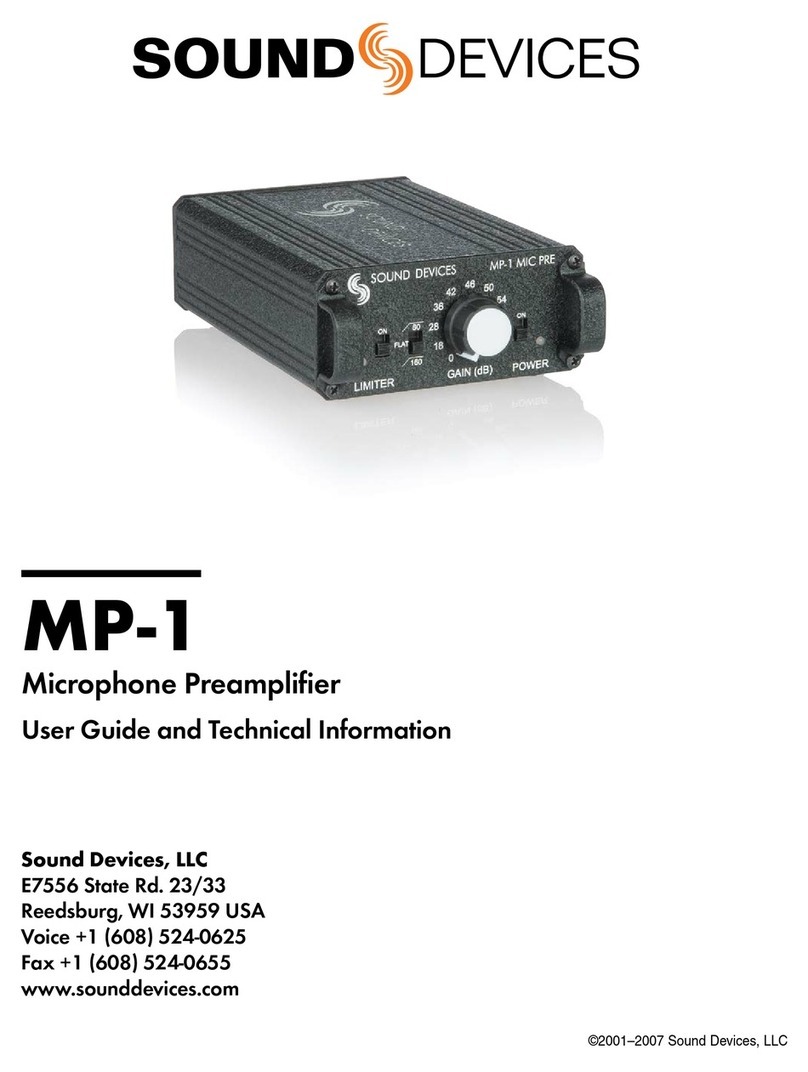
Sound Devices
Sound Devices MP-1 Manual
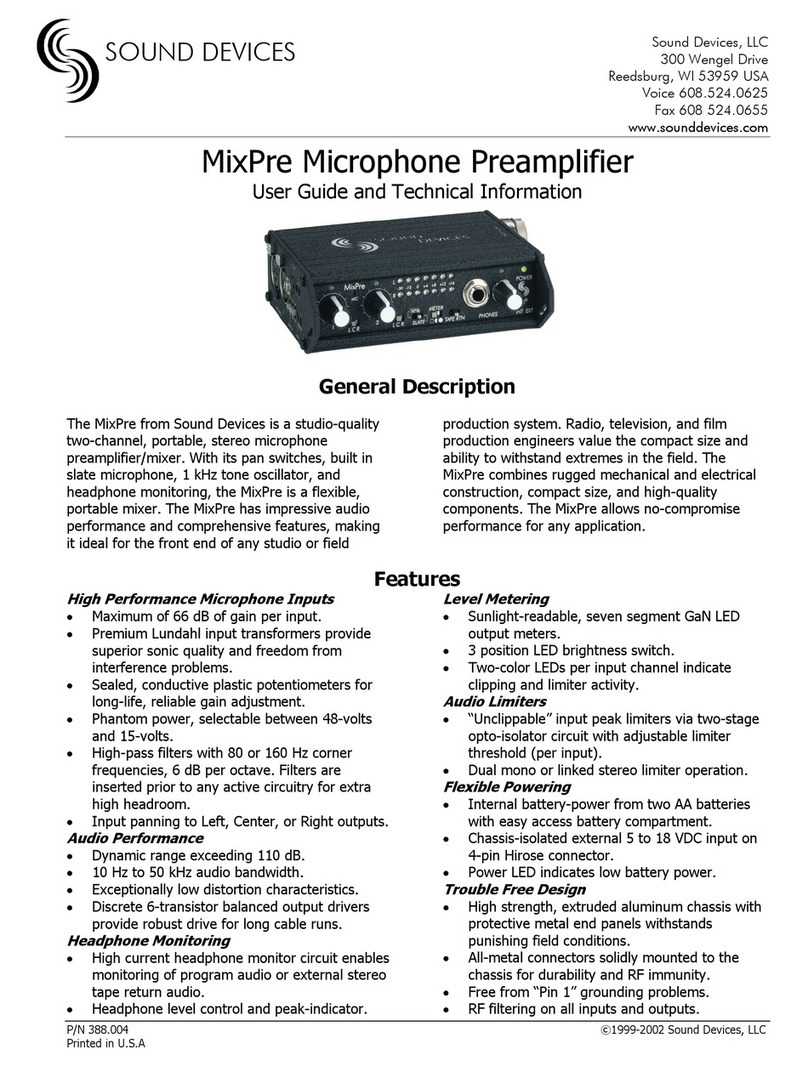
Sound Devices
Sound Devices MixPre User manual

Sound Devices
Sound Devices HX-3 User manual

Sound Devices
Sound Devices MixPre-D Manual
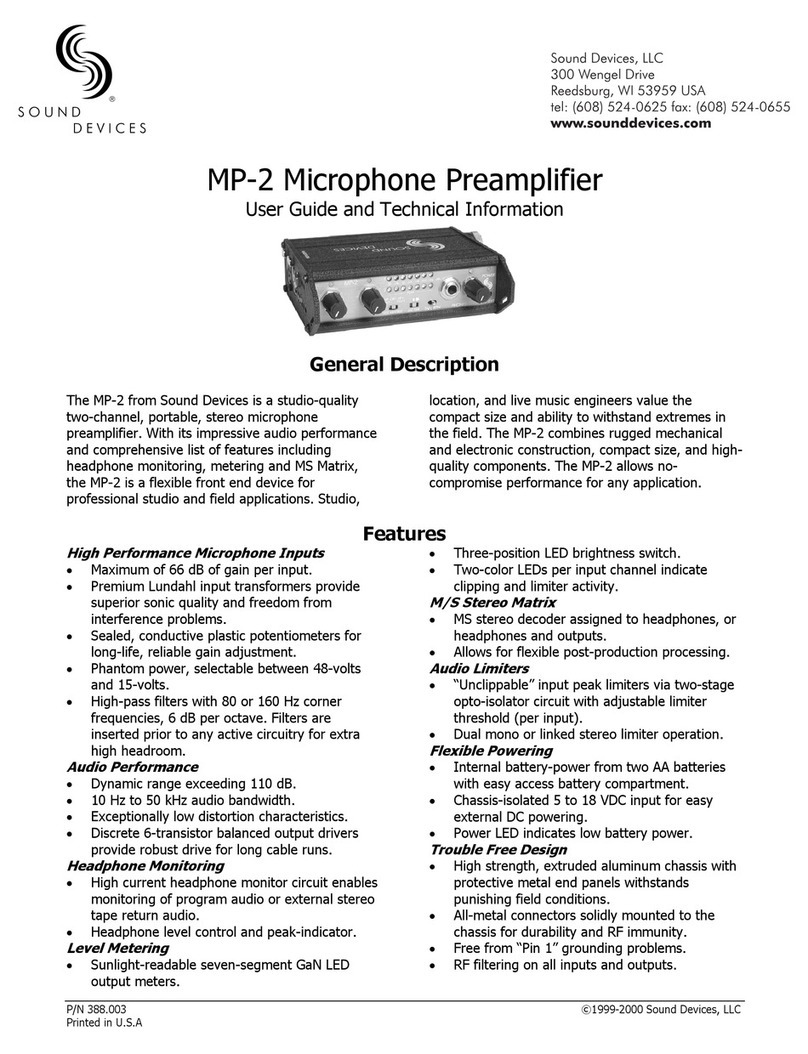
Sound Devices
Sound Devices MP-2 Manual

Sound Devices
Sound Devices MixPre User manual

Sound Devices
Sound Devices MP-1 Manual
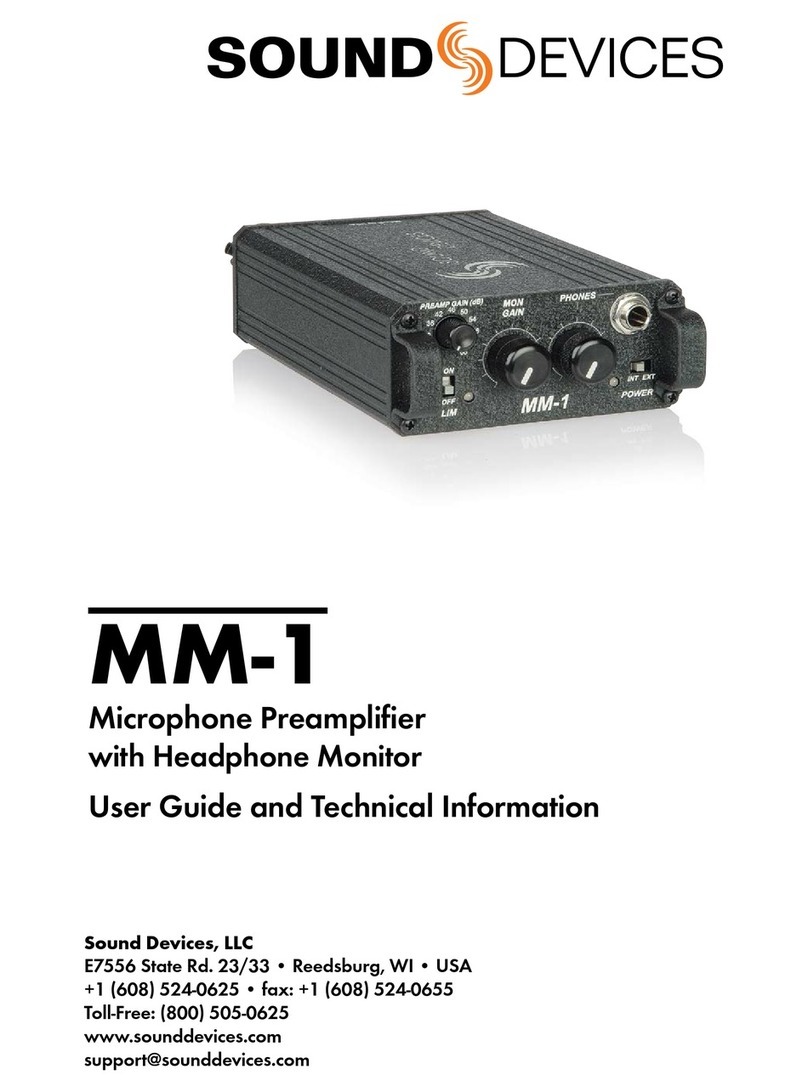
Sound Devices
Sound Devices MM-1 Manual
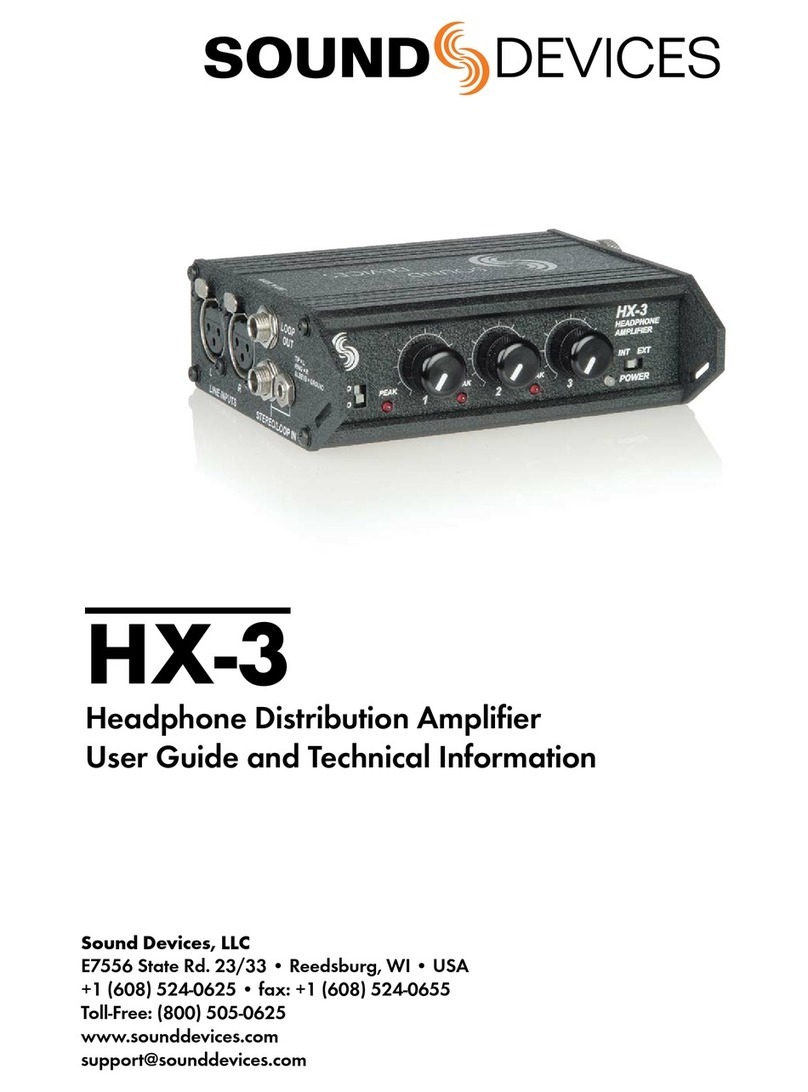
Sound Devices
Sound Devices HX-3 Manual
